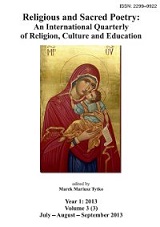Репрезентация новозаветной традиции в современном контексте
Representation of the New Testament Tradition in a Modern Context
Author(s): Irina TarangulSubject(s): Language and Literature Studies
Published by: Fundacja Naukowa Katolików »Eschaton«
Keywords: traditional structures; literary gospel; motive of treachery; continuation; appendage and apocryphasation
Summary/Abstract: The purpose of the article is to study the trends of formal content representation, problem-thematic aspects of the traditional New Testament figurative plot material in a modern context. The theoretical and methodological concept of traditional plots and images of A. E. Niamtsu was chosen as a research methodology. Special attention is paid to the forms and ways of transformation of traditional structures suggested by A.E. Niamtsu: appendage, continuation and apocryphasation. The given article is a research one: our focus concentrates on the principles of the gospel’s artistic figurative plot material implementation in the context of twentieth century literature. The emphasize is given to the thought that the revival of the New Testament images, themes, motives in a modern context is connected with the society’s need to understand the existential contradictions of its’ era. Twentieth century literature is the most productive as to an active use of the traditional structures of the New Testament. The activation of the New Testament figurative plot material in the con-temporary art process is caused by the loss of moral guidelines which accompanied the social processes of the twentieth century. The preservation of moral and psychological “core” of the known sample without which its further transformation is impossible and is confirmed to be dominant in the process of the New Testament plots and images rethinking. The main tendencies of rethinking the betrayal motive as a dominant in characteristics of Judas image are given as an example. One of the specific features of the genre of “the literary gospel” is the development of new plot lines, and also focusing the author’s attention on the secon-dary characters for the canonical text is noted. Hence the idea of the most productive forms of the New Testament collisions rethinking: continuation, appendage and apocryphasation is used. The main statements of the article may be used in the development of the courses “The History of Foreign Literature” and “The traditional plots and images”. The proposed research results will serve as the basis for further investigations of the complex problem “The New Testament and Literature”. The study of the New Testament traditional structure transformation is rather a perspective for further research of their individual aspects: conjugation peculiarities polyphony and modernity in new versions, the study of transformational polyphony of female characters of the New Testament and the perception study of the canonical text in the postmodern tendency.
Journal: Religious and Sacred Poetry: An International Quarterly of Religion, Culture and Education
- Issue Year: 2013
- Issue No: 3
- Page Range: 35-44
- Page Count: 10
- Language: Ukrainian

